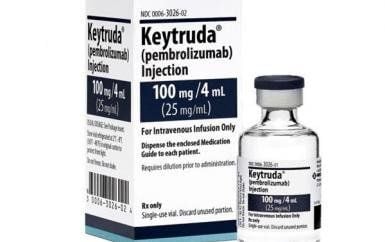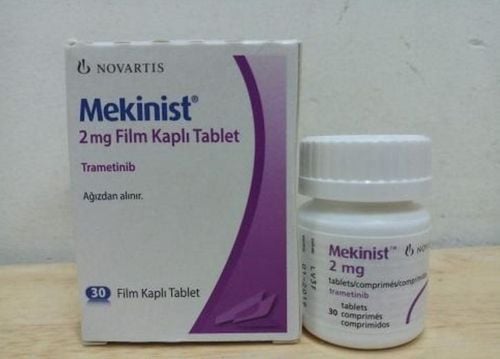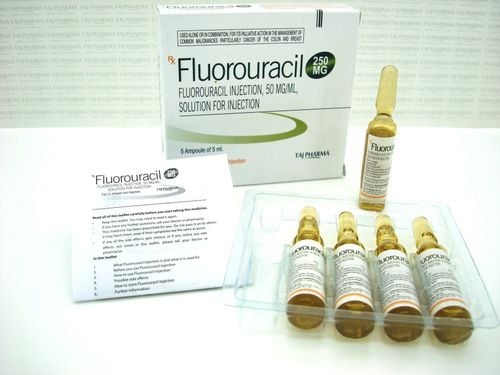This is an automatically translated article.
What is Gemcitabine, is it a cancer treatment drug? In fact, Gemcitabine is a cancer treatment drug whose main ingredient is Gemcitabine hydrochloride. Thanks to its inhibitory effect on DNA synthesis, Gemcitabine is used in the treatment of ovarian carcinoma, breast cancer, lung cancer, ... in combination with some other drugs.1. What is Gemcitabine?
Gemcitabine belongs to the group of anti-cancer drugs, anti-metabolism, synthesizing pyrimidine nucleosides, with the main ingredient being Gemcitabine hydrochloride. This active substance has an inhibitory effect on DNA synthesis. Gemcitabine is prepared in the form of a powder for intravenous infusion with concentrations from 200mg, 1g, 1.5g, 2g and solution for infusion with concentrations of 10mg/ml, 30mg/ml, 100mg/ml.Gemcitabine is used in the following cases:
Treatment of advanced carcinoma of the ovary in combination with carboplatin in patients who have relapsed after at least 6 months of platinum-containing therapy. Initial treatment of metastatic breast cancer in combination with paclitaxel after failure of anthracycline-containing regimens. Treatment of advanced or late-stage or metastatic pancreatic carcinoma in situ. Gemcitabine is indicated for first- or second-line therapy in patients previously treated with fluorouracil. Initial treatment of non-small cell lung cancer in combination with cisplatin when the disease is inoperable, locally advanced, or metastatic. Bladder cancer treatment.
2. How to use and dose Gemcitabine drug
Gemcitabine is administered intravenously. The medication is usually given over 30 minutes and is taken by a healthcare professional or doctor. During treatment, the patient should follow the doctor's instructions and depending on the patient's response, the doctor will prescribe the appropriate dose. If the condition becomes severe or does not get better, the person should tell the doctor right away.
Gemcitabine dosage in adults for each specific treatment purpose is as follows:
Treatment of ovarian carcinoma: Intravenous infusion of 1,000mg/m2 body surface area/time/day for 30 minutes. Administer the drug on the first and eighth days of the 21-day treatment cycle. Carboplatin was given as a combination intravenous infusion on day 1 of a 21-day treatment cycle. Treatment of breast cancer: Gemcitabine intravenous infusion at a dose of 1,250mg/m2 body surface area/time/day for 30 minutes. Administer the drug on the first and eighth days of the 21-day treatment cycle. Paclitaxel was infused at a dose of 175 mg/m2 on the first day before the infusion, infused over 3 hours. Treatment of large cell lung cancer: For a treatment schedule every 4 weeks, Gemcitabine intravenous infusion at a dose of 1,000 mg/m2 body surface area/time/day for 30 minutes. Administer the drug on the first and eighth days of the 21-day treatment cycle. Cisplatin was infused at a dose of 100 mg/m2 on the first day after the infusion. For a 3-week treatment schedule, Gemcitabine was infused intravenously at a dose of 1,250 mg/m2 body surface area once daily for 30 minutes. Administer the drug on the first and eighth days of the 21-day treatment cycle. Cisplatin was infused at a dose of 100 mg/m2 on the first day after the infusion. Treatment of pancreatic cancer: Gemcitabine intravenous infusion at a dose of 1,000mg/m2 body surface area/time/day for 30 minutes. From week 1 to week 8, use 1 week and take 1 week off. From week 8, the drug is infused on days 1, 8 and 15 of a 28-day treatment cycle. Gemcitabine overdose can cause rash, skin ulcers, mucositis, dysesthesia, myelosuppression and more severe manifestations of some side effects. So far, there is no specific antidote, patients are mainly treated with supportive and symptomatic treatment.
In case of early detection of Gemcitabine overdose, it is necessary to use anti-emetics and anti-diarrheals to relieve symptoms, and monitor electrolytes and water balance.
3. Gemcitabine side effects
Gemcitabine can cause some unwanted side effects with the frequency of occurrence as follows:
Common: Stomatitis, nausea, vomiting, diarrhea or constipation. Fever, pain, edema, peripheral edema, pruritus, rash, alopecia, irritation at injection site. Thrombocytopenia, leukocytes, neutrophils, anemia, hemorrhage. Increased transaminases, alkaline phosphatase, bilirubin, blood urea nitrogen, creatinine, hematuria, proteinuria. Shortness of breath, bronchospasm, flu-like syndrome, somnolence, dysesthesia, bacterial infection. Uncommon: Gemcitabine rarely causes anorexia, insomnia, headache, fatigue, sweating, muscle tremors. Rhinitis, cough, acute respiratory failure, interstitial pneumonia, pulmonary edema. Anaphylaxis, skin blistering, tissue inflammation, peripheral vasculitis, folliculitis, subcutaneous hemorrhage, inflammation after radiation therapy. Hypertension, arrhythmia, supraventricular arrhythmia, myocardial infarction, congestive heart failure, cerebrovascular accident. Increased GGT, blood urea, hepatotoxicity, liver failure, renal failure, respiratory failure, necrosis, sepsis. If you see any strange symptoms after taking Gemcitabine, you should immediately report it to your doctor or go to a medical facility for examination.
4. Some notes when using Gemcitabine drug
Do not use Gemcitabine in people with hypersensitivity to the ingredients of the drug, women who are breastfeeding. Reduce the dose of Gemcitabine in elderly patients and women because of its long half-life and reduced clearance. Gemcitabine can make some liver diseases worse, such as hepatitis, cirrhosis, alcoholic cirrhosis, liver failure, liver metastases. For patients with renal impairment, before each administration, complete blood count, liver and kidney function should be checked. During the course of taking the drug and after stopping the drug, it is also necessary to check the liver and kidney function. In addition, if the patient is taking Gemcitabine with cisplatin, magnesium, calcium, and potassium levels should be checked. Pregnant and nursing women should not take Gemcitabine, because of its toxicity to the fetus and this risk should be warned if the patient is taking the drug pregnant. Gemcitabine may interact and increase or decrease the concentration and effects of certain drugs and radiation therapy. In addition, Gemcitabine is also incompatible with some drugs. Therefore, before taking the drug, the patient needs to carefully study the list of drugs that interact and are incompatible with Gemcitabine, and provide a list of drugs, herbal products or supplements that are currently being used or used before. let the doctor know. The use of Gemcitabine is to inhibit DNA synthesis and is used in combination with some drugs to treat ovarian carcinoma, breast cancer, lung cancer, pancreatic cancer, and bladder cancer. The use of the drug requires a prescription from a doctor to ensure the best effect.
Please dial HOTLINE for more information or register for an appointment HERE. Download MyVinmec app to make appointments faster and to manage your bookings easily.













